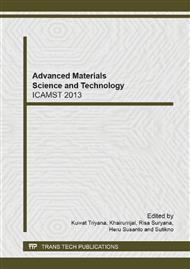p.229
p.233
p.237
p.241
p.245
p.249
p.253
p.259
p.263
Effect of Electrolyte Composition on Corrosion Resistance in Nickel Plating Process for Coating Bonded Magnet PrFeB
Abstract:
Despite of its excellence magnetic quality, one of the critical properties of PrFeB based permanent magnet is a low corrosion resistance so it can be oxidized easily which can reduce its magnetic properties. In this study, Nickel coating has been performed for bonded PrFeB magnet by the electroplating method using Nickel-Watts bath-type as the electrolyte to improve the corrosion resistance. The varying amount of the electrolyte compounds used to have the optimized composition indicated by the corrosion resistance measurement. The solution composition used was NiSO4 (230-380 g/L), NiCl2 (30-60 g/L), and H3BO3 (30 and 45 g/L) with a fixed value of other parameters. Characterization used including the immersion corrosion test, microstructure analysis, and magnetic properties. Based on the corrosion rate measurement, the highest corrosion resistant of Nickel coated PrFeB magnet achieved from the electrolyte composition of NiSO4: NiCl2: H3BO3 = 380: 60: 30 g/L with a plating time and current density (J) of 60 minutes and 40 mA/cm2 respectively. The corrosion rate data showed that the Nickel metal coating can improve the corrosion resistance of bonded PrFeB magnet up to 29 times than of the substrate. The SEM images showed that the thickness of the Nickel coating on the optimum electrolyte composition was in average value of 35.1 µm. The overall samples has a magnetic remanence value (Br) reached ≥ 6 kG, so it has enough properties to be applied in devices such as generators and electric motors.
Info:
Periodical:
Pages:
245-248
Citation:
Online since:
February 2014
Price:
Сopyright:
© 2014 Trans Tech Publications Ltd. All Rights Reserved
Share:
Citation:


